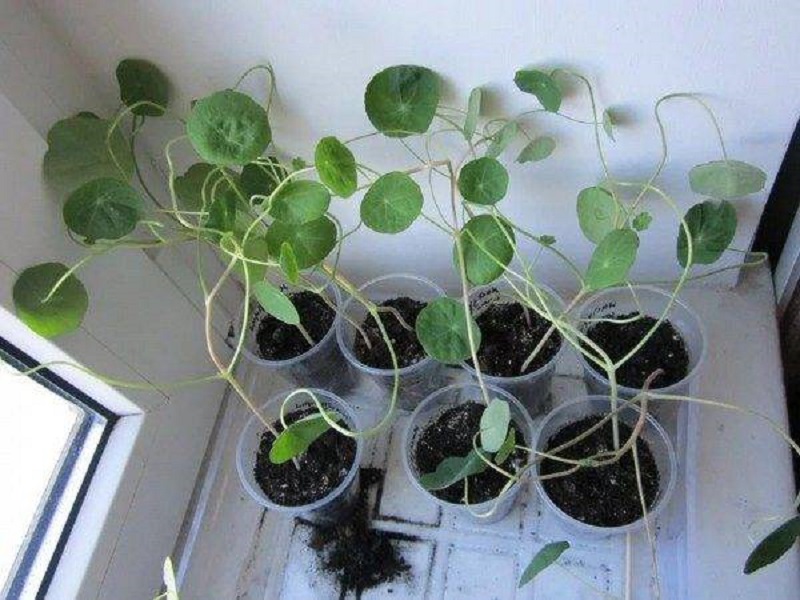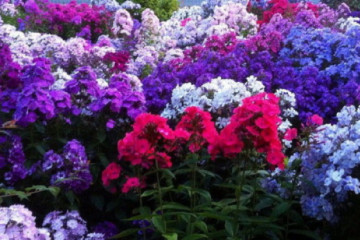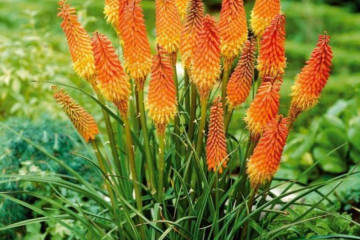Nasturtium planting and care in the open field
Content:
The leading positions in the list of popular horticultural crops are occupied by nasturtiums, planting and caring for them in the open field will not be difficult and will not take much time. With its help, you can implement many interesting solutions when creating a landscape design for a personal plot and enjoy the beautiful flowering of culture throughout the summer season. When growing, it is important to plant the bushes in the right place and properly organize their care.
Botanical features of the plant
Nasturtium is a perennial and annual herb of the Nasturtium family. His homeland is Latin America. In floriculture, there are 25 species of this graceful flower, while breeders know about 90 species.
The fibrous rhizome is located close to the soil surface. Stems, depending on the variety, can be creeping, branched, curly and reach up to 2-3.5 m in height. The bushes are decorated with alternate petiole leaves of a thyroid, lobed shape. They have a glossy surface with a waxy coating and a light green color. The edge of the leaf plate is solid, slightly wavy.
Large, in appearance resembling gramophones, flowers attract attention. They grow on long pedicels in the leaf axils. When nasturtium blooms, the buds give off an intense, pleasant, delicate scent. The color of the petals can be yellow, orange, pink, crimson.
The culture is not demanding to care for and has a long flowering. Therefore, many gardeners plant this flower, and a wide selection of varieties allows you to choose a short or tall plant that has fragrant, simple, semi-double and double flowers and a different structure of leaves.
Knowing when nasturtium blooms, in which month the buds bloom, you can create spectacular compositions in the garden and embody different ideas. The culture can be used both for landscaping the garden and for decorating a balcony or veranda.
Growing from seeds
Nasturtium can be diluted in two ways: by sowing seeds directly into open soil and by growing seedlings at home. This interesting and entertaining process does not require certain subtleties.
Time to board
To get early flowering bushes, you need to grow seedlings from seeds. When to plant nasturtium when grown from seed depends on the region of planting. Spring (late March or early April) is considered a favorable period for this procedure, in regions with a cold climate - mid-May.
Choice of capacity
Biocontainers, pots made of peat, plastic, cups with a removable bottom up to 10 cm in diameter are suitable as containers for the construction of nasturtium seedlings. The best solution is to take peat tablets for this purpose.
Soil and seed preparation
Before sowing seeds, you need to prepare them. To do this, carry out the following procedure:
- Sort by removing underdeveloped, small and damaged seeds.
- Place the inoculum for 15 minutes in a potassium permanganate solution heated to 60 ° C for disinfection.
- Then put the seeds in a gauze cloth and send them to cool water for 24 hours.
- For intensive future growth, they can be germinated a little, and then planted in pots.
The soil substrate can be used in the store or you can make it yourself by taking turf, sand, peat in equal parts. Mix and sift all ingredients well. Heat the resulting mixture with a hot potassium permanganate solution and leave in the room for 1-2 days. Then fill the containers with them and you can start sowing.
Sowing
In containers with prepared soil, make a 2 cm depression. Place 2-3 seeds in each pot. Squeeze the soil a little and water using a spray bottle. This will not wash out the soil and keep the seeds in place. Cover the planting containers with foil, glass to create a greenhouse.
Seedling care highlights
If you plant good quality seeds, the sprouts will begin to sprout within 15 days. There are some things to look out for when caring for nasturtium seedlings. It is important to adhere to the following guidelines.
Suitable temperature
When growing seedlings, it is important to observe the temperature regime (20-22 degrees). Under such conditions, the first shoots will not be long in coming. 2 weeks after sowing, the temperature can be reduced by 2 degrees.
Watering
Watering is carried out as the soil dries up. Flowers prefer dry air and do not need to be sprayed. Do not allow moisture to enter the plants. Water should be poured at the root.
Lighting
In poor light, seedlings can stretch out, become weak, and when planted in a flower bed, they will not please with flowering for a long time. Therefore, daylight hours when erecting seedlings should be 15 hours. This can be achieved by using a phytolamp for additional lighting.
Picking
This technique is very difficult for gardeners, so it is recommended to do without it. If the seedlings are elongated, then transplanting will help to correct the situation, in which one should not be afraid to bury the plants to the base of the first leaves.
Propagation by cuttings
You can get nasturtium by using the method of propagation by cuttings, in which all the varietal and specific characteristics of the mother plant are preserved.
To do this, adults, well-grown shoots with 3-4 leaves to be cut off. The lower cut is recommended to be treated with a growth stimulant.
Root cuttings in wet sand or water. As the roots are formed, they must be transplanted into the prepared soil in containers or on a flower bed. It is important to be careful not to damage the root system when planting.
Terry nasturtium is bred in this way, it is also recommended for very rare varieties, the seeds of which are difficult to buy.
Nasturtium - planting and care in the open field
Planting is an important stage, since the abundance and quality of flowering, as well as the plant's resistance to diseases, pests, and weather changes, depend on it.
First of all, you need to decide where to plant nasturtium: in the sun or in the shade. When choosing a site, it is important to choose lighted, protected from strong winds places. Since nasturtium will grow poorly in the shade and will not please with lush flowering. The soil should be fertile, light, well-drained and slightly acidic.
Landing dates
Plant nasturtium seedlings in the garden after the frost has passed, when the soil has warmed up to 10-12 ° C.The best time is mid-May, in cold regions, Siberia - early June.
Landing rules
Before planting young plants in open ground, it is necessary to dig holes, observing the distance between them 20-25 cm for compact varieties, and 40 cm for climbing varieties. Install a reliable support next to tall nasturtiums immediately after planting.
Flowering will begin in 1-1.5 months and will last until the first autumn frosts.
Every gardener who wants to grow a luxurious flower in his flower bed should pay more attention to care and know what are the optimal conditions to organize the plant for the full development and formation of buds. When it comes to such a flower as nasturtium, care and cultivation involve the implementation of such activities as watering, feeding, pinching, pruning.
Watering
Water abundantly in the first weeks before flowering, after which you need to sharply reduce the amount of irrigation. Moisten with warm water only. It is also imperative to loosen the trunk circle after each watering.
Top dressing
Beautiful flowering can only be achieved with moderate nutrient intake. At the same time, it is necessary to abandon organic substances, nitrogen fertilizers that stimulate the growth of green mass.
Nasturtium does not require frequent feeding. Over the summer, it is enough to fertilize the culture once before flowering, applying a liquid concentrated fertilizer Agricola (1 tbsp. L of the product per 10 liters of water) and Nitrofoska. They are balanced in composition and easy to use.
Pinching
It is recommended to pinch long shoots so that the plant is more lush and miniature.
Pruning
Pruning is done to stimulate lush flowering. All wilted flowers must be removed from the plant in a timely manner. Cut off dead stems and leaves using a sharp knife.
Seed collection
Nasturtium, which can be grown not only from purchased seeds, is reluctant to share seeds. The owner needs to monitor the condition of the fruits formed from the flowers. As they mature, they increase in size and turn whitish.
For seeds, it is better to leave the largest fruits. It is important to collect seed immediately, otherwise it will fall to the ground.
Disease and pest control
The content of nasturtium involves taking preventive measures in the fight against infections and parasites. There is nothing complicated, even a florist without experience can do it. The culture is endowed with a specific smell that repels many harmful insects. Sometimes the plant can suffer from cabbage whitefly, miner flies, aphids, spider mites. Systemic insecticides will help to neutralize harmful insects.
If you take care of the culture incorrectly, then it can also be affected by diseases:
- gray rot, in which dry brown spots form on the foliage;
- bacterial wilting, which at the initial stage is manifested by yellowing of the lower leaves, and then by wilting of the entire bush;
- rust, which is diagnosed by black and brown blotches on the leaf plates.
Treatment consists in the destruction of the infected parts of the plant and processing them with chemical and bacteriological preparations.
It is impossible not to love nasturtium. She exudes positive, she is especially good during the flowering period. Knowing how to plant nasturtium, you can transform your personal plot beyond recognition. Bright and mesmerizing flowers will cause a lot of enthusiastic looks and pleasant compliments.























